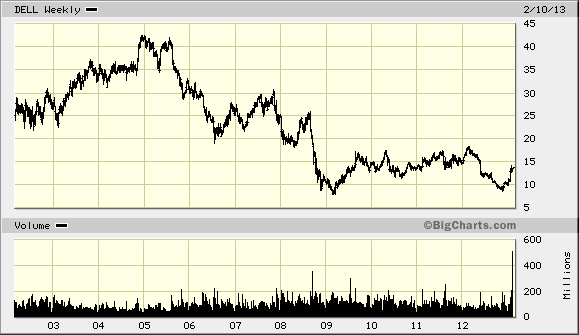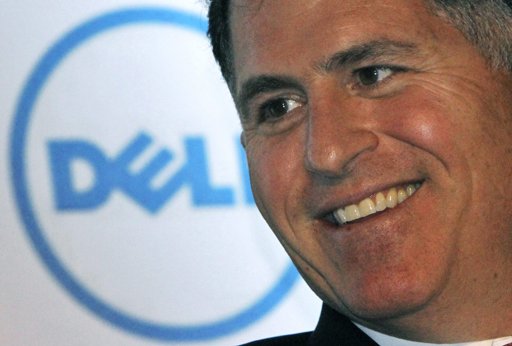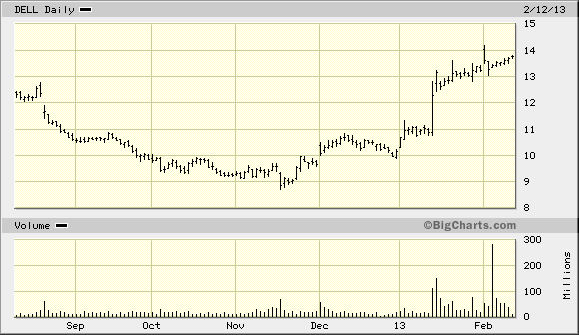We first spoke here of Dell http://wp.me/p2OaYY-1G2
Dell Case Study
So begins my analysis of Dell. Please be aware that I have been a recent shareholder of Dell, but no longer own shares. These comments should be taken in context of potential self-serving, hindsight bias. My methods may or may not be applicable to your investing, but I will lay out my assumptions.
First, I look at Dell_VL_2013. I love Value-Line for all the historical information that it packs into one page. However, I use it for a first screen and as a tickler to focus my reading when I go to the proxy and annual reports. Next, I go to the history of Return on total capital (“ROTC”) and ROE. In 2002 Dell had almost a 40% return on total capital averaging close to 50% until the plunge down to 17% in 2009—not unexpected given that computers could be considered a capital good. Use of debt was minimal.
My eye notices that ROTC has not really recovered to the pre-2009 glory days and now averages about 14%, a normal return on assets for an average business. Having read about Dell over the years, I know Dell had a business process advantage. Dell had a lower cost structure in computer assembly and distribution over its competitors. If you go to www.hbs.org you can download dozens of case studies on Dell’s manufacturing advantage. The market and competitors changed. Dell lost its cost advantage RELATIVE to its competitors. Now Dell is a commodity business. The proof lies in the history of its ROTC.
Next, I see sales growth per share about quadrupled from 1996 to 2000 during the Internet boom/bubble before flattening out at a ten-year 5.2% compounded annual growth rate from $35 billion in revenues in 2002 to about say $57 billion estimated in 2012. Wow, a big sales deceleration.
Dell has been buying back shares continually since 2001 both to sop up option issuance and shrink share count. My eyeball says management started shrinking the share count by 900 million shares from 2001 at an average price of $25—almost 90% above Dell’s current $13.65 offer. Dell’s management spent roughly $22.5 billion on share buybacks. The shareholders who remain sit with a current market cap at $24 billion (1.73 billion outstanding shares times $13.7 current share price). The shareholders who sold are the ones who benefited while the long-term and long-suffering shareholders saw the firms capital squandered.
If Dell’s management destroyed capital buying their OWN company, what does that say about their ability to make acquisitions outside their area of expertise going forward? I wonder….?
I jump to Dell’s proxies:2012 Dell Proxy and 2010 Dell Proxy. Michael Dell already owns about 13% of Dell which I don’t begrudge him since he did create the company and develop a better way to assemble and distribute than his competitors, for a time.
But why does he receive a dollop of 500,000 options every year? How does receiving more options incentive him more than his 13% stake and on top of his generous salary? My prejudice is that Mr. Dell looks out for number one first and shareholders second. I think Dell comparing itself to Intel in its peer group is absurd. Intel has to spend much more on R&D, for example, than Dell. They are different businesses. Dell’s compensation plan has the makings of fancy consultants. Read more on M. Dell’s compensation: http://www.footnoted.com/perk-city/dells-tale-of-two-proxies/
For a brief history but biased slant: http://www.motherjones.com/politics/2011/02/michael-dell-outsourcing-jobs-timeline
Now from Dell’s 2012 Letter to Shareholders Dell Sh Letter 2012:
I’m proud to report we delivered on that promise in fiscal year 2012. We made big investments to expand our portfolio of solutions and capabilities and to build an expert global workforce to deliver them to our millions of customers. By the end of the year, enterprise solutions and services accounted for roughly 50 percent of gross margins—a record result, and great validation that we’re on the right road and delivering the technology solutions our customers need.
I am excited about our future. Information technology is a $3 trillion industry, and we currently have roughly a two-percent share. The opportunity to grow and, more importantly, to help our customers achieve their goals is tremendous. That is—and will always be—our ultimate goal.
That ladies and gentlemen is called the “Chinese Glove Theory.” If I can garner 1% of the Chinese Glove market by getting 1% to 2% of the 2 billion Chinese to wear one glove (like Michael Jackson), we will be rich. Of course, what edge do I have and/or profits will be made doing that relative to competitors?
Ok, Dell has made big investments to grow but how does Dell have a competitive advantage in any of its businesses? If I can’t answer that question—and I can’t—then Dell’s GROWTH has NO value, zilch, nada, none. Returning money via dividends and share purchases is good provided the company shrinks itself faster than the decline in its business or does not squander its cash with overpriced acquisitions or share buybacks.
Note the average annual P/E ratio has moved down from the hyper growth 62 P/E in 1999 all the way down to the current 6 or 7 P/E net of cash. High expectations have collapsed to low expectations. Good, I seek low expectations.
Also, note the wisdom of crowds (the market). See the dotted line showing Dell’s share price relative to the market that declines from the end of 2002 to today. Note the decline accelerating while Dell made a high of $42.60 during 2005. The market (like it is doing with Apple today) was and is handicapping Dell’s future prospects. The “market” sensed the change in competitive dynamics occurring in Dell’s business. Respect the market because the onus is on you to be right or contrary to the consensus.
So what is the business worth?
Post tax “cash flow” is about $1.90 per share. Capex is estimated at 30 cents per share, but it was 38 cents per share in 2011 and back in 2006 and 2007 almost 40 cents. I want to err on the side of conservative so I put 40 cents for capex. $1.90 per share in “cash flow” minus 40 cents leaves me about $1.50 in free cash flow (“FCF”). For a discount rate with NO GROWTH I use about 11% to 12% because that rate is the average equity return for an average business. Yes the 30 year bond (“risk-free”) rate is 4% but normalized the rate is closer to 6% or 7% and I think historically the equity premium has ranged much higher (go read The Triumph of the Optimists for a history of equity premiums by country).
$1.50 divided by my discount rate of 11.5% leaves $13 per share for the operating business. The excess cash is $11.3 billion in cash minus $5.3 billion in long-term debt or $6 billion in net cash or about $3.50 per share. But I can’t get my hands on that cash, and taxes would have to be paid to repatriate that cash—I will knock off 25% and use $2.50 to add back to my operating value. I see that total debt is $9 billion so I need to check out the terms of the debt, but I will use $2.5 per share to add to $12. 50 to $13 per share operating business value with no growth of $1.50 per share FCF using a 11% to 12% discount rate.
My back of the envelope value is $15 to $16.5 per share. Now, that value range assumes no growth but also no decline. I am receiving about 4% per year of the $1.50 in free cash flow in dividends and share buybacks. On the other hand, I have Mr. Dell’s high compensation, poor capital allocation record on share buybacks, and “me-first” attitude towards shareholders.
Since growth has no value, I am buying a non-franchise type company. Profitable growth will not bail me out, so I need a 30% to 40% discount for my margin of safety AND I can’t make it more than 2% to 3% of my portfolio. A major position for me is 5% to up to 15%. 30% to 40% discount from $15 to $16 leaves me a buying range of about $9 to $11. I will be conservative and look at $15 as my level of value so $9 to $10.50 will be my range. I bought in Sept. 2012 at about $10.60 and again in November at about $9.15 for an average price of $9.80.
Yes, I could be making all this up with hindsight bias, but this is from a simple man.
Upon the announcement of Dell going private, I waited a day and sold at $13.55. Why sell when the minimum value I placed on it was $15 and up to $16 per share? I am not an arbitrageur. I will leave it to them to make the last nickel or dollars. The business seems cheap, but I ride with a poor capital operator in a commodity business. I don’t see much future value and perhaps I was TOO AGGRESSIVE in my valuation. My return for investing in Dell is 39% for six months. Good, but it doesn’t factor in my losses for when I buy a “Dell” and all hell breaks loose and I may have to sell at $5 or $7. But I had excess cash, free cash flow, shareholder angst (Pzena and Southeastern) and LOW EXPECTATIONS at my back. My expectations of management and the business were low as well, but perhaps not low enough. Time will tell.
If you read Southeastern’s letter Dell-Board-Letter_by_Longleaf, they place a value of $24 on Dell (Southeastern paid about an average of $25 for Dell’s stock over the past five years (see 13-FH filings). They mention Dell paying about $12.94 per share at cost for their acquisitions buttressed by Dell’s CFO saying to that point had delivered a 15% internal rate of return. Perhaps, but I am skeptical that Dell’s acquisitions will generate more than an average rate of return. What does Dell bring to the party in its acquisitions? Scale? Technology, Patents? Customer captivity? Ironically, if Dell isn’t worth at least $13 per share for those acquisitions, then Dell’s current bid is another nail in the coffin for its reputation in building shareholder value.
I do agree with Southeastern’s letter that Dell should allow shareholders the option to remain invested in the company if they so choose while breaking up the company. If shareholders have traveled this far, let them decide. Basically, Michael Dell wants to use more cheap debt (available today) as a tax shield to juice his after-tax returns. I don’t blame him, but let the shareholders decide.
Beware of sum of the parts valuations. If you do use them, analyze the competitive advantages of each business segment.
I could spend a year on Dell reading about their divisions but I would have no edge over industry analysts. My edge (I hope) is sniffing out despair with a cynical eye.
Dell is not an obscure, forgotten company/stock, but it was laden with disappointment, despair and low expectations. I just had to wait for my price or walk away.
Hope this helps you to find our own way.
UPDATE: FEB. 12, 2013:
Mason Hawkins Buys More Dell While Opposing the Deal
—
I will be out until Friday………until then.



